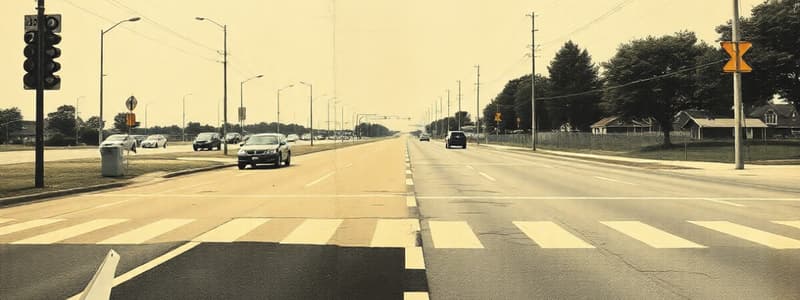Podcast
Questions and Answers
What is a primary component of rigid pavement design?
What is a primary component of rigid pavement design?
- Joint spacing (correct)
- Base course material
- Subgrade preparation
- Bituminous surface layer
When conducting traffic studies, which characteristic is NOT typically analyzed?
When conducting traffic studies, which characteristic is NOT typically analyzed?
- Traffic volume
- Driver behavior
- Road surface texture (correct)
- Vehicle speed
Which method is primarily associated with the construction of WBM roads?
Which method is primarily associated with the construction of WBM roads?
- Bituminous mixing
- Asphalt pouring
- Layered aggregate placement (correct)
- Concrete slab casting
Which of the following is NOT considered a traffic control device?
Which of the following is NOT considered a traffic control device?
What are the 3 E's of traffic management?
What are the 3 E's of traffic management?
Flashcards are hidden until you start studying
Study Notes
Pavement Design and Traffic Engineering
- Flexible pavement: A pavement constructed using layers of unbound materials, such as gravel and asphalt, which can deform under load. It is commonly used in areas with low traffic volume and less heavy vehicles.
- Rigid Pavement: A pavement constructed with a layer of concrete, which is able to withstand heavy loads and traffic. It is typically used in areas with high vehicular traffic and heavy loads.
### Design Factors
- Traffic characteristics: Number, weight, and speed of vehicles using the road.
- Environmental factors: Climate, rainfall, and temperature.
- Soil conditions: Strength and bearing capacity of the underlying soil.
- Material properties: Strength and durability of construction materials.
Traffic Characteristics
- Traffic volume: Number of vehicles using a specific section of road. It can be calculated by counting vehicles during a specific time period.
- Vehicle type: Trucks, cars, buses, and motorbikes affect the design of the road due to their weight and the number of axles they have.
- Speed distribution: Average speed and variation in speed of vehicles.
- Traffic flow: Movement of vehicles on a roadway. It is influenced by factors such as the road geometry, traffic density, and driver behavior.
Traffic Studies
- Traffic surveys: Gathering information about traffic flow, volume, and composition.
- Origin and destination studies: Identifying where people are travelling from and to.
- Speed studies: Determining the speed of vehicles on a particular road.
Construction and Maintenance
- WBM (Water Bound Macadam): A pavement using crushed stone and water.
- Surface dressing: A layer of aggregate bound by bituminous material, applied to an existing road surface to improve friction and reduce wear.
- Bituminous roads: Roads constructed with a layer of asphalt, which is a mixture of aggregates and bituminous binders.
- Road parking system: A planned system for allocating parking spaces along roads. It can include on-street parking, off-street parking, and various parking restrictions.
Traffic Control Devices
- Traffic signals: Lights that control traffic flow at intersections.
- Signs: Provide information and instructions to drivers.
- Road markings: Lines and symbols painted on the road to guide traffic flow.
3 E's of Traffic
- Engineering: Designing and constructing roads that are safe and efficient.
- Enforcement: Enforcing traffic laws and regulations.
- Education: Educating drivers about traffic safety and good driving practices.
Studying That Suits You
Use AI to generate personalized quizzes and flashcards to suit your learning preferences.



